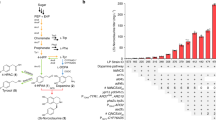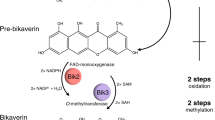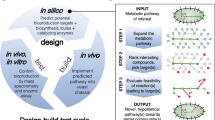Abstract
Structurally complex and diverse polyamines and polyamine analogues are potential therapeutics and agrochemicals that can address grand societal challenges, for example, healthy ageing and sustainable food production. However, their structural complexity and low abundance in nature hampers either bulk chemical synthesis or extraction from natural resources. Here we reprogrammed the metabolism of baker’s yeast Saccharomyces cerevisiae and recruited nature’s diverse reservoir of biochemical tools to enable a complete biosynthesis of multiple polyamines and polyamine analogues. Specifically, we adopted a systematic engineering strategy to enable gram-per-litre-scale titres of spermidine, a central metabolite in polyamine metabolism. To demonstrate the potential of our polyamine platform, various polyamine synthases and ATP-dependent amide-bond-forming systems were introduced for the biosynthesis of natural and unnatural polyamine analogues. The yeast platform serves as a resource to accelerate the discovery and production of polyamines and polyamine analogues, and thereby unlocks this chemical space for further pharmacological and insecticidal studies.

This is a preview of subscription content, access via your institution
Access options
Access Nature and 54 other Nature Portfolio journals
Get Nature+, our best-value online-access subscription
$29.99 / 30 days
cancel any time
Subscribe to this journal
Receive 12 digital issues and online access to articles
$119.00 per year
only $9.92 per issue
Buy this article
- Purchase on Springer Link
- Instant access to full article PDF
Prices may be subject to local taxes which are calculated during checkout




Similar content being viewed by others
Data availability
Raw sequencing data is available on ArrayExpress with accession number E-MTAB- 9898. Data supporting the findings of this study are available within the article and its Supplementary Information files: the accession numbers and nucleotide sequences (codon optimized or original) of the enzymes referenced in this study are provided in this paper; source data are provided with this paper as Source Data files. All other data that support the findings of this study are available from the corresponding author upon reasonable request. All plasmids and strains used in this study are available from the corresponding author under a material transfer agreement. Source data are provided with this paper.
Code availability
All code used in the model simulations is available in GitHub (https://github.com/foodgeoff2010/Polyamine_platform).
References
Gerland, P. et al. World population stabilization unlikely this century. Science 346, 234–237 (2014).
Campisi, J. et al. From discoveries in ageing research to therapeutics for healthy ageing. Nature 571, 183–192 (2019).
Luo, X. et al. Complete biosynthesis of cannabinoids and their unnatural analogues in yeast. Nature 567, 123–126 (2019).
Galanie, S., Thodey, K., Trenchard, I. J., Filsinger Interrante, M. & Smolke, C. D. Complete biosynthesis of opioids in yeast. Science 349, 1095–1100 (2015).
Lee, S. Y. et al. A comprehensive metabolic map for production of bio-based chemicals. Nat. Catal. 2, 18–33 (2019).
Pardee, K. et al. Portable, on-demand biomolecular manufacturing. Cell 167, 248–259 (2016).
Li, S., Li, Y. & Smolke, C. D. Strategies for microbial synthesis of high-value phytochemicals. Nat. Chem. 10, 395–404 (2018).
Chen, R., Yang, S., Zhang, L. & Zhou, Y. J. Advanced strategies for production of natural products in yeast. iScience 23, 100879 (2020).
Madeo, F., Eisenberg, T., Pietrocola, F. & Kroemer, G. Spermidine in health and disease. Science 359, eaan2788 (2018).
Li, Y.-Y. et al. Identification and characterization of kukoamine metabolites by multiple Ion monitoring triggered enhanced product Ion scan method with a triple-quadruple linear Ion trap mass spectrometer. J. Agric. Food Chem. 63, 10785–10790 (2015).
Mounce, B. C., Olsen, M. E., Vignuzzi, M. & Connor, J. H. Polyamines and their role in virus infection. Microbiol. Mol. Biol. Rev. 81, e00029-17 (2017).
Antoniou, A. I., Pepe, D. A., Aiello, D., Siciliano, C. & Athanassopoulos, C. M. Chemoselective protection of glutathione in the preparation of bioconjugates: the case of trypanothione disulfide. J. Org. Chem. 81, 4353–4358 (2016).
Walters, D., Meurer-Grimes, B. & Rovira, I. Antifungal activity of three spermidine conjugates. FEMS Microbiol. Lett. 201, 255–258 (2001).
Jagu, E. et al. Synthesis and antikinetoplastid evaluation of bis(benzyl)spermidine derivatives. Eur. J. Med. Chem. 150, 655–666 (2018).
Bassard, J.-E., Ullmann, P., Bernier, F. & Werck-Reichhart, D. Phenolamides: bridging polyamines to the phenolic metabolism. Phytochemistry 71, 1808–1824 (2010).
Michael, A. J. Biosynthesis of polyamines and polyamine-containing molecules. Biochem. J. 473, 2315–2329 (2016).
Michael, A. J. Polyamines in eukaryotes, bacteria, and archaea. J. Biol. Chem. 291, 14896–14903 (2016).
Miller-Fleming, L., Olin-Sandoval, V., Campbell, K. & Ralser, M. Remaining mysteries of molecular biology: the role of polyamines in the cell. J. Mol. Biol. 427, 3389–3406 (2015).
Nielsen, J. & Keasling, J. D. Engineering cellular metabolism. Cell 164, 1185–1197 (2016).
Zhou, Y. J. J. et al. Modular pathway engineering of diterpenoid synthases and the mevalonic acid pathway for miltiradiene production. J. Am. Chem. Soc. 134, 3234–3241 (2012).
Liu, Q. et al. Rewiring carbon metabolism in yeast for high level production of aromatic chemicals. Nat. Commun. 10, 4976 (2019).
Caspi, R. et al. The MetaCyc database of metabolic pathways and enzymes—a 2019 update. Nucleic Acids Res. 48, D445–D453 (2019).
Orth, J. D., Thiele, I. & Palsson, B. Ø. What is flux balance analysis? Nat. Biotechnol. 28, 245–248 (2010).
Kurian, L., Palanimurugan, R., Gödderz, D. & Dohmen, R. J. Polyamine sensing by nascent ornithine decarboxylase antizyme stimulates decoding of its mRNA. Nature 477, 490–494 (2011).
Phillips, M. A., Coffino, P. & Wang, C. C. Cloning and sequencing of the ornithine decarboxylase gene from Trypanosoma brucei. J. Biol. Chem. 262, 8721–8727 (1987).
Qin, J. et al. Modular pathway rewiring of Saccharomyces cerevisiae enables high-level production of l-ornithine. Nat. Commun. 6, 8224 (2015).
Hamasaki-Katagiri, N., Tabor, C. W. & Tabor, H. Spermidine biosynthesis in Saccharomyces cerevisiae: polyamine requirement of a null mutant of the SPE3 gene (spermidine synthase). Gene 187, 35–43 (1997).
Pegg, A. E. Toxicity of polyamines and their metabolic products. Chem. Res. Toxicol. 26, 1782–1800 (2013).
Albers, E. Metabolic characteristics and importance of the universal methionine salvage pathway recycling methionine from 5′-methylthioadenosine. IUBMB Life 61, 1132–1142 (2009).
Toms, A. V., Kinsland, C., McCloskey, D. E., Pegg, A. E. & Ealick, S. E. Evolutionary links as revealed by the structure of Thermotoga maritima S-adenosylmethionine decarboxylase. J. Biol. Chem. 279, 33837–33846 (2004).
Yerlikaya, A. & Stanley, B. A. S-adenosylmethionine decarboxylase degradation by the 26S proteasome is accelerated by substrate-mediated transamination. J. Biol. Chem. 279, 12469–12478 (2004).
Becker, M. A., Smith, P. R., Taylor, W., Mustafi, R. & Switzer, R. L. The genetic and functional basis of purine nucleotide feedback-resistant phosphoribosylpyrophosphate synthetase superactivity. J. Clin. Investig. 96, 2133–2141 (1995).
Hu, H. et al. DNA shuffling of methionine adenosyltransferase gene leads to improved S-adenosyl-l-methionine production in Pichia pastoris. J. Biotechnol. 141, 97–103 (2009).
Roje, S. et al. Metabolic engineering in yeast demonstrates that S-adenosylmethionine controls flux through the methylenetetrahydrofolate reductase reaction in vivo. J. Biol. Chem. 277, 4056–4061 (2002).
Darbani, B., Stovicek, V., van der Hoek, S. A. & Borodina, I. Engineering energetically efficient transport of dicarboxylic acids in yeast Saccharomyces cerevisiae. Proc. Natl Acad. Sci. USA 116, 19415–19420 (2019).
Uemura, T., Tachihara, K., Tomitori, H., Kashiwagi, K. & Igarashi, K. Characteristics of the polyamine transporter TPO1 and regulation of its activity and cellular localization by phosphorylation. J. Biol. Chem. 280, 9646–9652 (2005).
Tachihara, K., Uemura, T., Kashiwagi, K. & Igarashi, K. Excretion of putrescine and spermidine by the protein encoded by YKL174c (TPO5) in Saccharomyces cerevisiae. J. Biol. Chem. 280, 12637–12642 (2005).
Panicot, M. et al. A polyamine metabolon involving aminopropyl transferase complexes in Arabidopsis. Plant Cell 14, 2539–2551 (2002).
Ober, D. & Hartmann, T. Homospermidine synthase, the first pathway-specific enzyme of pyrrolizidine alkaloid biosynthesis, evolved from deoxyhypusine synthase. Proc. Natl Acad. Sci. USA 96, 14777–14782 (1999).
Knott, J. M., Römer, P. & Sumper, M. Putative spermine synthases from Thalassiosira pseudonana and Arabidopsis thaliana synthesize thermospermine rather than spermine. FEBS Lett. 581, 3081–3086 (2007).
Petchey, M. R. & Grogan, G. Enzyme-catalysed synthesis of secondary and tertiary amides. Adv. Synth. Catal. 361, 3895–3914 (2019).
Eudes, A. et al. Exploiting members of the BAHD acyltransferase family to synthesize multiple hydroxycinnamate and benzoate conjugates in yeast. Microb. Cell Factories 15, 198 (2016).
Costa, M. A. et al. Characterization in vitro and in vivo of the putative multigene 4-coumarate:CoA ligase network in Arabidopsis: syringyl lignin and sinapate/sinapyl alcohol derivative formation. Phytochemistry 66, 2072–2091 (2005).
Eichenberger, M. et al. Metabolic engineering of Saccharomyces cerevisiae for de novo production of dihydrochalcones with known antioxidant, antidiabetic, and sweet tasting properties. Metab. Eng. 39, 80–89 (2017).
Zhou, K., Qiao, K., Edgar, S. & Stephanopoulos, G. Distributing a metabolic pathway among a microbial consortium enhances production of natural products. Nat. Biotechnol. 33, 377–383 (2015).
Müller, K., Faeh, C. & Diederich, F. Fluorine in pharmaceuticals: looking beyond intuition. Science 317, 1881–1886 (2007).
Kim, S.-K., Jin, Y.-S., Choi, I.-G., Park, Y.-C. & Seo, J.-H. Enhanced tolerance of Saccharomyces cerevisiae to multiple lignocellulose-derived inhibitors through modulation of spermidine contents. Metab. Eng. 29, 46–55 (2015).
Ljungdahl, P. O. & Daignan-Fornier, B. Regulation of amino acid, nucleotide, and phosphate metabolism in Saccharomyces cerevisiae. Genetics 190, 885–929 (2012).
Gumulya, Y. et al. Engineering highly functional thermostable proteins using ancestral sequence reconstruction. Nat. Catal. 1, 878–888 (2018).
Li, C., Zhang, R., Wang, J., Wilson, L. M. & Yan, Y. Protein engineering for improving and diversifying natural product biosynthesis. Trends Biotechnol. 38, 729–744 (2020).
Narayan, P., Ehsani, S. & Lindquist, S. Combating neurodegenerative disease with chemical probes and model systems. Nat. Chem. Biol. 10, 911–920 (2014).
Zhang, J., van den Herik, B. M. & Wahl, S. A. Alpha-ketoglutarate utilization in Saccharomyces cerevisiae: transport, compartmentation and catabolism. Sci. Rep. 10, 12838 (2020).
Mans, R. et al. CRISPR/Cas9: a molecular Swiss army knife for simultaneous introduction of multiple genetic modifications in Saccharomyces cerevisiae. FEMS Yeast Res. 15, fov004 (2015).
Luo, H. et al. Coupling S-adenosylmethionine-dependent methylation to growth: design and uses. PLoS Biol. 17, e2007050 (2019).
Mikkelsen, M. D. et al. Microbial production of indolylglucosinolate through engineering of a multi-gene pathway in a versatile yeast expression platform. Metab. Eng. 14, 104–111 (2012).
Gietz, R. D. & Schiestl, R. H. High-efficiency yeast transformation using the LiAc/SS carrier DNA/PEG method. Nat. Protoc. 2, 31–34 (2007).
Canelas, A. B. et al. Quantitative evaluation of intracellular metabolite extraction techniques for yeast metabolomics. Anal. Chem. 81, 7379–7389 (2009).
Heirendt, L. et al. Creation and analysis of biochemical constraint-based models using the COBRA Toolbox v.3.0. Nat. Protoc. 14, 639–702 (2019).
Bolger, A. M., Lohse, M. & Usadel, B. Trimmomatic: a flexible trimmer for Illumina sequence data. Bioinformatics 30, 2114–2120 (2014).
Deatherage, D. E. & Barrick, J. E. Identification of mutations in laboratory-evolved microbes from next-generation sequencing data using breseq. Methods Mol. Biol. 1151, 165–188 (2014).
Shi, L. et al. Evolution of bacterial protein-tyrosine kinases and their relaxed specificity toward substrates. Genome Biol. Evol. 6, 800–817 (2014).
Altschul, S. F. et al. Gapped BLAST and PSI-BLAST: a new generation of protein database search programs. Nucleic Acids Res. 25, 3389–3402 (1997).
Shannon, P. et al. Cytoscape: a software environment for integrated models of biomolecular interaction networks. Genome Res 13, 2498–2504 (2003).
Nakamura, T., Yamada, K. D., Tomii, K. & Katoh, K. Parallelization of MAFFT for large-scale multiple sequence alignments. Bioinformatics 34, 2490–2492 (2018).
Capella-Gutiérrez, S., Silla-Martínez, J. M. & Gabaldón, T. trimAl: a tool for automated alignment trimming in large-scale phylogenetic analyses. Bioinformatics 25, 1972–1973 (2009).
Price, M. N., Dehal, P. S. & Arkin, A. P. FastTree 2—approximately maximum-likelihood trees for large alignments. PLoS One 5, e9490 (2010).
Goodstein, D. M. et al. Phytozome: a comparative platform for green plant genomics. Nucleic Acids Res. 40, D1178–D1186 (2011).
Edgar, R. C. MUSCLE: multiple sequence alignment with high accuracy and high throughput. Nucleic Acids Res. 32, 1792–1797 (2004).
Stamatakis, A. RAxML version 8: a tool for phylogenetic analysis and post-analysis of large phylogenies. Bioinformatics 30, 1312–1313 (2014).
Acknowledgements
This work was funded by the Novo Nordisk Foundation (NNF10CC1016517), the Swedish Foundation for Strategic Research and the Knut and Alice Wallenberg Foundation. We thank J. Zhang, I. Borodina and Q-L. Liu for helpful discussions, J. Zhang for kindly providing plasmids from the CRISPR/Cas9 genome editing system, Q-L. Liu and Y. Chen for kindly providing aromatic chemical overproducing strains, A. Hoffmeyer for genome sequencing, M. Gossing, D. Romero-Suarez, the Chalmers Mass Spectrometry Infrastructure and the Analytical Core Facility of the Novo Nordisk Foundation Center for Biosustainability at Technical University of Denmark for assistance with metabolite analysis.
Author information
Authors and Affiliations
Contributions
J.Q. and J.N. conceived the study with input from A.K. (spermidine section). J.Q. designed and performed the experiments, analysed the data and drafted the manuscript. M.K. assisted with the MS-based metabolite analysis. B.J., Y.C. and E.Ö. assisted with the computational and bioinformatic analysis. M.K.J., J.D.K., A.K. and B.J. assisted with the data analysis and interpretation. J.N., M.K.J. and J.D.K. supervised the study. All the authors revised and approved the manuscript.
Corresponding author
Ethics declarations
Competing interests
J.Q., J.N. and A.K. are listed as inventors on patent applications related to microbial production of polyamines and/or polyamine analogues. J.Q. and J.N. are scientific co-founders of Chrysea Ltd. A.K. and J.N. are shareholders in Biopetrolia AB. J.D.K. has interests in Amyris, Lygos, Demetrix, Napigen, Maple Bio, Apertor Labs, Ansa Biosiences and Berkeley Brewing Sciences. All the other authors declare no competing interests.
Additional information
Peer review information Nature Catalysis thanks Rajib Saha and the other, anonymous, reviewer(s) for their contribution to the peer review of this work.
Publisher’s note Springer Nature remains neutral with regard to jurisdictional claims in published maps and institutional affiliations.
Supplementary information
Supplementary Information
Supplementary methods, references and Figs. 1–.45.
Supplementary Tables
Supplementary Tables 1–15.
Supplementary Data
Source Data for Supplementary Figs. 2–8.
Source data
Source Data Fig. 2
Statistical Source Data for Fig. 2.
Source Data Fig. 3
Statistical Source Data for Fig. 3.
Rights and permissions
About this article
Cite this article
Qin, J., Krivoruchko, A., Ji, B. et al. Engineering yeast metabolism for the discovery and production of polyamines and polyamine analogues. Nat Catal 4, 498–509 (2021). https://doi.org/10.1038/s41929-021-00631-z
Received:
Accepted:
Published:
Issue Date:
DOI: https://doi.org/10.1038/s41929-021-00631-z
This article is cited by
-
Engineered Saccharomyces cerevisiae for de novo δ-tocotrienol biosynthesis
Systems Microbiology and Biomanufacturing (2024)
-
Light-driven biosynthesis of volatile, unstable and photosensitive chemicals from CO2
Nature Synthesis (2023)
-
De novo biosynthesis of rubusoside and rebaudiosides in engineered yeasts
Nature Communications (2022)
-
Highly efficient biosynthesis of spermidine from L-homoserine and putrescine using an engineered Escherichia coli with NADPH self-sufficient system
Applied Microbiology and Biotechnology (2022)
-
Modular biocatalysis for polyamines
Nature Catalysis (2021)



